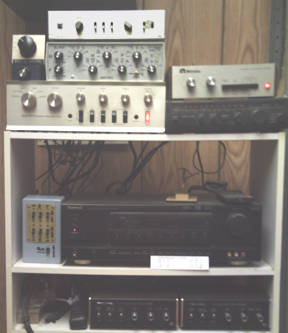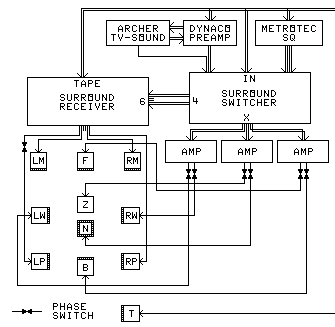|
When surround sound first appeared in the late 1960s, various systems were developed by different
companies and individuals for the purpose of using the existing phonograph record, recording tape,
and stereo radio technologies for surround sound. Of course, the worst thing possible happened.
Each company created a different system and patented it, hoping to be the winner in the marketplace.
The result was chaos.
|
|
All of the surround sound systems are based on either a multiple-track recording method, or some
kind of encoding and decoding system. Those using an encoding and decoding system have a decoder
inserted into the sound system at some point. Most systems insert the decoder after the pre-amp.
Others insert it after the phonograph pickup cartridge, or between the power amplifier and the
speakers. Read the instructions to find out where the decoder belongs. Of course, all of the
components after the decoder must be duplicated, so there are four channels.
Note that some of the systems are now totally unavailable. For example, none of the experimental
FM quadraphonic systems would be in use today, because the Federal Communications Commission (FCC)
never approved any of them until long after interest was gone. So decoders for these systems are
totally useless today (but there also were none sold).
On the other hand, quadraphonics is not dead. It is transformed. In 1976, a system appeared that
outperformed all of the old quadraphonic systems. It is Dolby Stereo, originally created for the
movie Star Wars. It solved two of the problems the old systems could not solve: Placing a
sound image to the side of the listener, and keeping the front center vocalist out of the back
speakers.
The old systems were withdrawn from the market, as Dolby Surround (the home version of Dolby
Stereo) took over the home market in 1982. At that time, "quadraphonics" was renamed
as "surround sound." Many more recordings have been issued in surround sound than were
ever issued in all of the old quadraphonic formats combined.
|
THE SIMPLE APPROACH TO QUADRAPHONICS
Quadraphonic recordings can be divided into these groups. Each needs its own player or
decoder:
- Discrete tape - 4 discrete tracks on tape.
- Tapes - Includes Reel-to-reel tapes and Q8 cartridges
- Players have 4-channel tape heads.
- Regular Matrix (RM) and (QM) - Simple sum and difference based matrices
- All media - Includes Dynaco, Stereo-4, QS, and Dolby Surround
- Two forms exist: symmetrical RM and front-oriented QM
- Can use Dolby Surround Pro Logic decoder
- Can use a passive surround decoder (e.g.
UniQuad UQ-1A)
- Phase Matrix (PM) - Based on CBS SQ matrix circular back encoding.
- All media - Includes SQ and Stereo-44
- Basic 10-40 decoder can play Regular Matrix. Logic decoder can not.
- Uniform Matrix (UX) - Matrix with phase shifts on all channels.
- All media - Includes BMX, UD-4, H, and Ambisonic
- Rare type - don't buy decoder unless you have records.
- CD-4 - A fragile radio frequency carrier on each groove wall for discrete
- Only records - Includes CD-4 discrete 4-channel
- Requires special pickup, now rare.
- Don't expect this to work unless records are pristine and very clean.
- Discrete digital encoding - 4 or more digital tracks.
- CDs & DVDs - Includes Dolby Digital, AC-3, DTS, and SACD
- Players have the decoders built in, and multiple outputs.
Get only the decoders and players you need, and use multiple input selector switches to select
the correct devices.
Quadraphonics can be added to an existing surround sound system with a 6-channel discrete
input.
More on Quadraphonic Compatibility
Build the UniQuad UQ-1A Quadraphonic Decoder
|
|
The Quadraphonic Systems page is a table containing all known
encoding systems, with information on how they work and how you can play them today. The stylus
modulations in the record groove are shown, so you can visualize the phase relationships. Tape
and stereo radio used the same matrix encoding means, but the phase relationships were not so
obvious. The Poincaré Energy Sphere is used as a tool to show the distance (and separation)
of any two of the modulations.
|
 F - Center Front speaker
F - Center Front speaker
